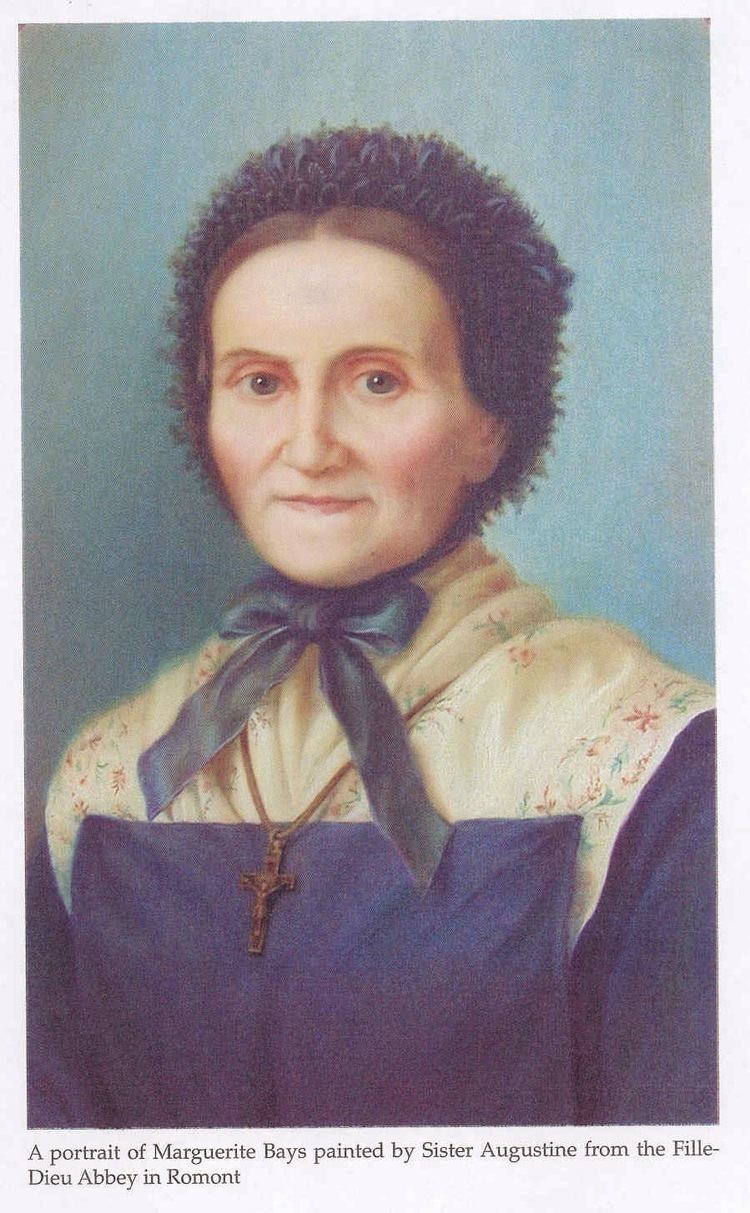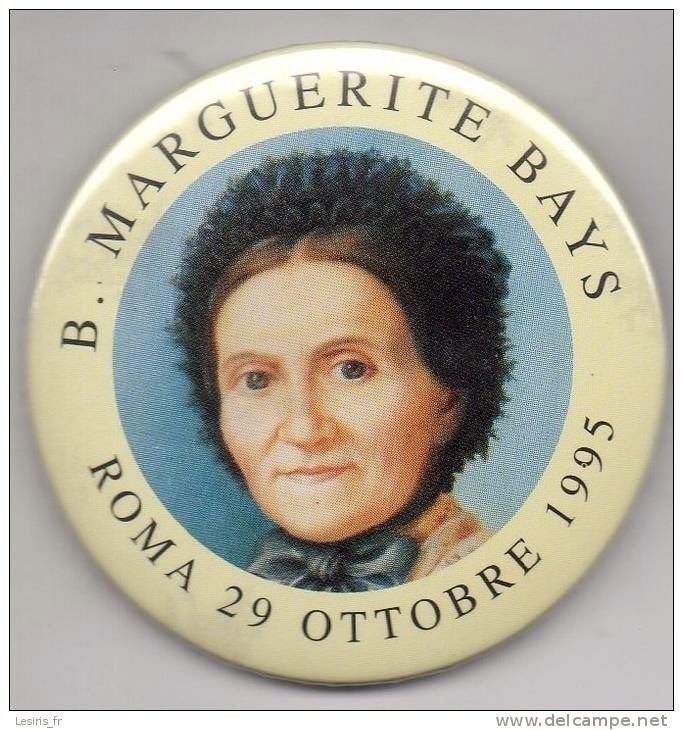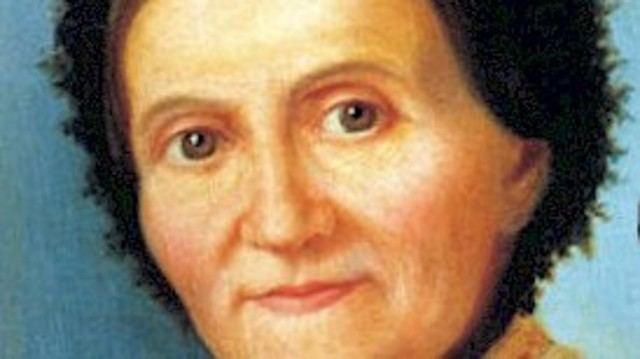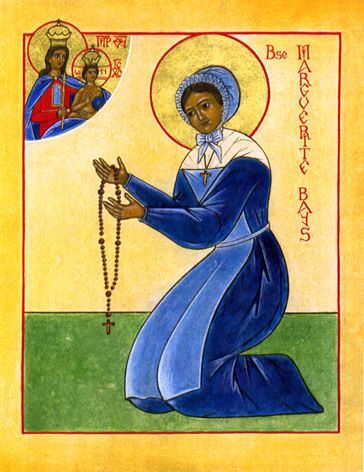Name Marguerite Bays Patronage Franciscan tertiaries | Attributes RosaryStigmata Feast 27 June | |
 | ||
Died June 27, 1879, Siviriez, Switzerland | ||
Venerated in Roman Catholic Church | ||
Blessed marguerite bays
Blessed Marguerite Bays (8 September 1815 – 27 June 1879) was a Swiss Roman Catholic member of the Secular Franciscan Order. She worked as a seamstress and also served as a catechist. She lived a simple life as a Franciscan and adapted the tenets of the order's charism into her own life and social apostolate. This became even greater after she was cured of bowel cancer on 8 December 1854 (when a Marian dogma was proclaimed) and she took this as a sign of greater service to both God and neighbor.
Contents
- Blessed marguerite bays
- Childhood and education
- Service to the poor
- Stigmata and death
- Beatification
- References

Her beatification process commenced after her death and culminated in 1995 after Pope John Paul II presided over her beatification. After her death in 1879, Pope John Paul II beatified her in 1995 after the recognition of a miracle attributed to her intercession. One final miracle is needed for her to be canonized.

Childhood and education

Marguerite Bays was born in La Pierraz - a hamlet of Chavannes-les-Forts in the canton of Fribourg - on 8 September 1815 as the second of seven children to Pierre-Antoine Bays and Josephine Morel. Her siblings were:

Her parents were devout and were farmers; she herself demonstrated great intelligence as a student (she studied at school in Chavannes-les-Forts) and demonstrated a particular though noted inclination towards reflection and contemplation while deciding to cease interacting with her peers at school in favor of the solitude of talking to God. In 1823 she received her Confirmation and received her First Communion in 1826. It was after this from 1830 that she was in an apprenticeship as a seamstress before offering her services as a seamstress to different households.

In her room at home she made a small altar where she placed flowers and a statue of the Madonna. Marguerite would awaken in the morning to request her intercession at the statue before going outside to do the duties of the farm. In her spare time she would tell children about the life of Jesus.
Despite the urgings of those around her she dismissed the prospects of becoming a professed religious. Instead it was her desire to remain single as a virgin in order to devote herself to an austere life for Jesus Christ. But pain struck their household: her sister Marie-Marguerite (known as "Mariette") saw the dissolution of her marriage; her brother Joseph (of a violent temper and relaxed manners) served a sentence in prison and the elder Claude had a child out of the marriage - François - of which Marguerite - then aged seventeen - took care of in terms of his education. Claude got married (aged 47 at the time) with Josette who - according to the testimonies of the relatives - was a woman of rude and indelicate character never losing the chance to humiliate and mistreat her sister-in-law. But Marguerite took care of Josette despite this for she was quite ill so as to prepare her for death.
Service to the poor
It was during her adolescence that some peasant farmers could no longer find work due to the introduction of mechanization in agriculture. But these troubles did not hinder her efforts to serve the poor for she carried milk and bread to them while she would also wash and mend their clothes or even give them new ones to use.
Her devotedness to service of the poor led her to discover the Secular Franciscan Order which she became a professed member. Marguerite attended Mass on a frequent basis despite a 20 minute walk in the neighboring village of Siviriez and she took part in the Eucharistic Adoration session following the celebration of the Mass. Marguerite also embarked on pilgrimages to Marian shrines.
Marguerite devoted part of her time on teaching catechism to children and often visited those who were ill. In 1853 she contracted bowel cancer and begged the Mother of God to heal her through her intercession. But at the same time she asked that her pain be linked with the suffering of Christ for her condition was her own Cross to bear. The disease first came when she began suffering from dizziness and acuta pain in her stomach as well as nausea that caused her often to vomit. But she tried to hide this and did not even take medicine for it until the condition was discovered and she was prompted to see a doctor who made the diagnosis and ruled out an operation. On 8 December 1854 - when Pope Pius IX proclaimed the dogma of the Immaculate Conception - she found that she was cured of her illness.
The mother abbess of a convent near her (also her goddaughter) Lutgarde Menétrey and the priest Joseph Schorderet often consulted with her in the founding of the Saint Paul's Work in 1873 which was an initiative that she both supported and encouraged despite the opposition of the Bishop of Fribourg Étienne Marilley.
Stigmata and death
Marguerite later discovered that she had the stigmata around 1854 and consulted with her local bishop to oversee the verification of just how authentic the stigmata were. In addition she began to fall into ecstatic raptures when she would feel the pain of Christ once a week marking His death. But she first tried to hide the wounds from the outside world though it soon slipped out and news spread about her stigmata.
The stigmata was first noticed when she felt intense burning and noticed red blotches appear on her hands as well as on her feet and at her chest. Marguerite was subjected to a medical examination on 11 April 1873 and the doctor allowed for her niece to be present for the examination. Jules Grangier visited her at her home to see the stigmata for himself sometime in 1873 after a series of requests made to see her.
In her last weeks she could have just little herbal tea as well as small amounts of milk and light bread soup. Her condition had taken a rapid spiral downwards throughout Lent of 1879 and she suffered from extreme pain during this period. Marguerite grew frail and thin and her brother Jean said she felt like a bag of bones when he had to lift her. No one knew what her condition was for she kept silent on her sufferings and instead offered her pain to God; all that was known was that she suffered from acute pain in her head as well as her throat and chest. Marguerite died at 3:00pm on 27 June 1879 following several weeks of severe suffering and her funeral took place on 30 June; her funeral saw hundreds of people attend. Her remains were later transferred sometime after her death to the parish church at Siviriez.
Beatification
The beatification process commenced in Switzerland in 1929 and closed not long after also in 1929. Another local process spanned from 1953 to 1955 and the two processes were ratified on 13 December 1985. Her writings were all investigated and received appropriate theological approval on 25 November 1956 after the determination was made that her writings adhered to Church doctrine and principles. The Positio was then forwarded to the Congregation for the Causes of Saints in Rome in 1986 for further evaluation. Theologians approved the dossier's contents on 13 February 1990 as did the cardinal and bishop members of the C.C.S. not long after on the following 19 June. Pope John Paul II approved that she had lived a life of heroic virtue and proclaimed her to be Venerable on 10 July 1990. A miracle was investigated and the process was ratified on 12 April 1991. Medical experts approved this miracle on 25 February 1993 as did theologians on 2 July and the C.C.S. on 16 November. John Paul II approved it on 23 December 1993 and beatified her on 29 October 1995 in Saint Peter's Basilica. The miracle that led to her beatification was the cure of Bernard Pochon in 1940.
The second miracle needed for her canonization was investigated and the process closed on 27 May 2014; this alleged miracle involves a girl from 1998 who was saved after what would have been a fatal tractor accident had her grandfather not invoked the intercession of the Blessed. The documents on the miracle were submitted to Rome. The C.C.S. issued a decree that validated this medical investigation on 1 October 2015.
The current postulator for this cause is the Dominican priest Bernard Hodel.
